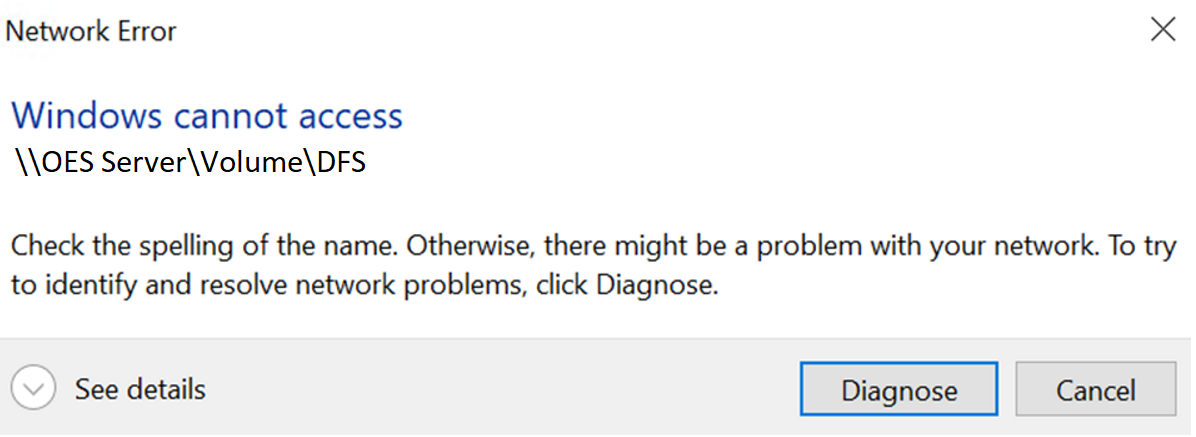2.3 Distributed File Services (DFS)
2.3.1 Windows Cannot Access Error
A permission denied error will appear for the user if Windows SMB Share or Windows Server are not available, or no trustee rights are available for the Windows SMB Share.
Figure 2-1 Error Message

2.3.2 CIFS eDir User can Access Non-OES Windows Target DFS Junction
If the Active Directory administrator permissions are granted to Windows share, the CIFS eDirectory user can access the DFS junction on the non-OES Windows target DFS junction.
2.3.3 Non-OES Target Validation Errors
By default, dfstool uses anonymous login to validate the non-OES SMB share without prompting the user for any credentials on the command line. The dfstool does not check the path for the existence of the path from the share. If the anonymous login is disabled on the server hosting the target then junction creation or modification might fail.
The i option can be used to establish the non-OES junction without verifying the existence of the target server or share:
-
dfstool -c /media/nss/VOL1/dir1/junc1 -t target_server_or_ip_address/share_name/path_to_target_folder -T non-oes -i
(or)
dfstool -c /media/nss/VOL1/dir1/junc1 -t target_server_or_ip_address/share_name/path_to_target_folder -T non-oes --ignore-targetpath-check
-
dfstool -m /media/nss/VOL1/dir1/junc1 -t target_server_or_ip_address/share_name/path_to_target_folder -T non-oes -i
(or)
dfstool -m /media/nss/VOL1/dir1/junc1 -t target_server_or_ip_address/share_name/path_to_target_folder -T non-oes --ignore-targetpath-check
2.3.4 NCP Clients Issues
-
NCP client does not list non-OES targets.
-
For DFS junction, the NCP client is unable to list all multiple targets. In a failover scenario, the NCP client cannot use the other target if one of the targets is unavailable as the NCP clients always points to the first target path.
2.3.5 iManager Issues
-
iManager is unable to list DFS junctions that point to multiple targets.
-
If an NSS volume has both OES and a non-OES junction, iManager junction scan lists only OES junctions. So, to view non-OES junctions, you must use dfstool.
-
When browsing through the NSS volume for modifying or deleting DFS junction, iManager does not list non-OES Windows junction target and only displays the OES junction.
2.3.6 RME must be Configured for DFS Junction Pointing to Multiple Targets
Cluster migrating a resource (which has a first target path) to another server (which has a second target path) followed by "vldb repair" would result in only one active target path until the user configures Resource Mutual Exclusion (RME).
2.3.7 DFS Junction Pointing to Non-OES Target using Windows Domain Name
-
If you have configured Windows DFS root namespace, you can create a DFS junction pointing to DFS root namespace or folder under the root namespace.
-
If you have not configured DFS Root Namespace, you cannot access the DFS junction target.
2.3.8 DFSTOOL Command Errors
-
Scan or list junction is unable to list DFS junctions that point to multiple targets.
-
Scan junction fails to work on non-replica VLDB servers and throws an error.
-
dfstool does not validate the special characters ($$, $!) appended to the share name and creates junction successfully.
-
dfstool throws an encryption issue even though the junction is successfully created when creating a junction with Netapp shares using the -A option.
-
When using DFS Namespace to generate a non-OES junction, dfstool incorrectly lists the non-OES junction target path because DFS Namespace is appended before the SMB target share.
Junction Name
Source Server
Source Path
Target Server
Target Path
Management Context
Status
junc1
OESserver
Vol1:/nonoes/
Windows_domain
DFSnamespace:/Winshare1/
*NA*
Available
junc2
OESserver
Vol1:/nonoes/
Windows_domain
DFSnamespace:/Winshare1/dir1
*NA*
Available